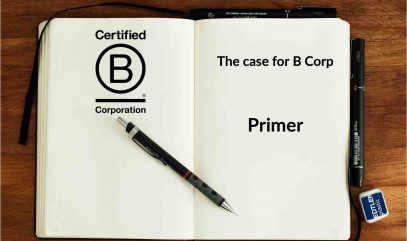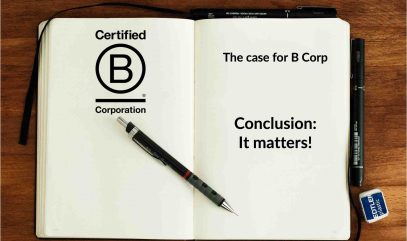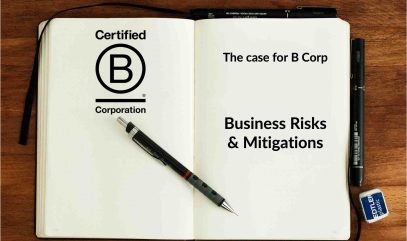The ROI of Purpose
In a mid-September blog post, we outlined the reasons we should all care about Sustainability. We highlighted the risks of climate change and global perceptions of those risks, consumer perceptions about the role of business in improving the environment, consumer willingness to support sustainable brands, and the higher financial performance of sustainable brands. In this post we build on those ideas to further make a case for the Return on Investment (ROI) of sustainability efforts.
…sure, but what’s the business case?
In our discussions about sustainability, someone will inevitably ask about the business case or the ROI for investing in sustainable business practices. In contrast, conversations about philanthropic giving rarely take that direction – it is generally assumed that philanthropy is a worthwhile endeavor. Businesses commonly view philanthropy as a natural, perhaps essential part of their business practice. Philanthropy is viewed as having an inherent value, and the business case is seemingly taken for granted.
Yet how many businesses thoroughly evaluate the ROI of each individual contribution let alone the ROI of their entire corporate giving program? Maybe “doing the right thing” eliminates the need to ask questions? Maybe the business case for philanthropy is just plainly obvious?
Milton Friedman argued that the sole role of business is to make money and increase profits, and he asserted that spending on philanthropy was antithetical to the purpose of a corporation. Friedman’s thinking strongly influenced corporate governance practices for four decades and has contributed greatly to the current focus on profitability and short-term growth. Given that businesses frequently look for opportunities to eliminate expenses, Friedman’s doctrine should have provided motivation (and cover) for businesses to curtail their giving. But corporations and businesses generally have not adopted Friedman’s philosophy on philanthropy. They instead make regular contributions and then spend large sums marketing their philanthropic contributions. In some cases, the money spent on marketing their philanthropy exceeds the philanthropic giving itself.
Recently, many companies, like Cisco and Salesforce.com, are adopting context-focused philanthropy to make a larger social and financial impact. These companies understand that philanthropy provides strategic and competitive advantages, builds their brands and reputations in communities, improves the communities where they do business, improves employee morale, and enhances business relationships and connections.
Working towards the ROI
To be clear, Sustainability is not philanthropy or an exercise in philanthropic giving. Sustainability is a fundamental change in business practices, in how businesses engage their customers, how they connect with communities and employees, and how they impact the environment. Sustainability is much broader and more transformative than philanthropy. Sustainability and sustainable practices ensure that you are maximizing business effectiveness and positioning your company to be viable and profitable in the future.
Perhaps asking about the ROI of Sustainability, or the ROI of taking action, is the wrong question to start with. Instead, we will look first at how the US economy will be impacted by changes in the environment in coming years. A recent report produced by The Hamilton Project and The Stanford Institute for Economic Policy Research quantified the potential economic costs for the US caused by rising global temperatures. “Climate change will affect agricultural productivity, mortality, crime, energy use, storm activity, and coastal inundation.” An increase of two degrees Celsius by 2080-99 equates to a loss of .5 percent of GDP (or nearly $100 billion) and an increase of four degrees Celsius equates to a loss of 2 percent of GDP (or nearly $400 billion). Impacts to GDP per capita could range from 1.0 percent to as much as 14.3 percent depending on the extent of the temperature increase. “For context, in 2019 a 5 percent US GDP loss would be roughly $1 trillion.” In other words, the impact of rising temperatures is far from trivial.
It is important to remember that this study focuses only on how a rise in temperature will impact the US economy as a whole and doesn’t give insight into the cost to individual businesses. The study also does not consider other negative impacts that businesses have on the environment and our communities. There are innumerable and seemingly unending examples of businesses polluting drinking water sources. And many other examples of pollution, deforestation, habitat destruction, etc., all of which have economic impacts. Despite all of that, the study begins to provide insight into the ROI of doing nothing.
Economics of Doing Something – Calculating ROI
If the economics of doing nothing leads to substantial losses, the economics of doing something generally can be assumed to be positive. Based on various studies and as seen throughout our blog series, a focus on sustainability can have positive business impacts:
- improve your ability to hire new talent
- improve retention of current employees
- increase employee engagement and boost morale
- improve employee health and reduce the number of sick days
- increase employee productivity (happy, healthy employees are more productive)
- attract and retain new customers
- enhance brand recognition and increase brand value
- provide a competitive differentiator between you and your competitors
- improve the health of the communities where you do business
- increase individual wealth, thereby creating more disposable income within communities where you do business
- sustain the health of surrounding environments and biodiversity
Translating those benefits into an actual ROI requires understanding consumer trends and demands. It also requires understanding how changes in certain metrics impact business performance. Lastly, getting to the ROI requires making some basic assumptions based on historical data and experience. The questions below provide an example of how to begin estimating the financial value of the benefits listed above:
- What is the ROI and impact to your business of being able to attract top-tier talent rather than mid-tier talent? How would productivity, innovation, and execution be impacted if you had more-talented resources? Consider that 64% of Millennials won’t take a job with a company that doesn’t show strong commitment to community and environment. If you aren’t focused on Sustainability, you are missing out on a large pool of talented resources.
- How much does it cost to hire an employee and what is the financial benefit of improved retention? What would happen if your top-talent left your business? Consider that 88 percent of Millennials find their job more satisfying when they have opportunities to positively impact social and environmental issues. If you aren’t focused on Sustainability, you miss out on a large resource pool of potential new employees and you lose an opportunity to increase engagement and thereby increase employee retention.
- What is the ROI of a 1-point increase in employee engagement and how does an increase in engagement impact overall productivity? Resources with higher engagement are more productive, more conscientious, and more likely to stay with a company. Sustainability efforts are an effective way at increasing engagement.
- How much does it cost to attract new customers? What is the value of a 1-point increase in Sales? What is the value of retaining customers? Consider that 81 percent of global consumers feel strongly that companies should help improve the environment. And 66 percent of people are prepared to pay more for sustainable brands (and 73 percent of Millennials will pay more). If you aren’t focused on Sustainability, you are potentially alienating a majority of consumers, missing an opportunity to sell more product, and generally putting your brand at risk.
- What is the value of your brand and how would you account for an improvement in brand recognition? Your brand has value and you have to work diligently to protect your brand image. Committing to sustainable practices will boost how people perceive your company and products, and thereby increase the value of your brand.
- How would a competitive advantage over competitors impact sales? Again, consider that 81 percent of consumers who expect business to improve the environment and 66 percent who will pay more for sustainable products. Sustainability currently provides an opportunity to differentiate yourself from competitors. We are in the midst of a highly competitive marketplace and every advantage counts.
- How would sales be impacted by an increase in per capita wealth in the communities where you do business? In other words, how would your business benefit if all households had more disposable income? The more money people have left-over after paying for necessities, the more they have to spend on your products and services.
- How would your business be impacted due to transportation delays caused by inaccessible roads (e.g., wash outs, blockades due to fires or wind damage)? How would products or services be impacted by unclean or polluted water? By declining crop yields resulting from a lack of pollinators, wind damage, soil damage, etc.? Correspondingly, how does your business benefit from having access to clean water, clean air, dependable transportation, consistent agricultural production, etc.? The costs and benefits of maintaining a healthy environment currently are not priced into products, but they do have a significant impact on your business.
There isn’t a single number that quantifies the positive impact of Sustainability. However, these questions provide a starting point for estimating how your business may benefit from a change in business practices. Developing a simple model based on these questions and other factors can help you evaluate how benefits change based on different variables.
The actual ROI of Sustainability for any company is highly dependent on what they commit to and how they manage their efforts. Small changes in practices lead to small improvements and financial benefits, while larger changes will generally create larger impacts and benefits. Similarly, if Sustainability is thought of as a stand-alone project divorced from the rest of the business strategy, the ROI is likely to be rather low. If Sustainability is a core part of the business strategy and closely integrated into all business practices, the ROI will be substantially higher and become a key driver of financial success. Like anything else, you get out what you put in.
Overthinking the obvious leads to missed opportunities
At one point in time, the use of computers and technology was a fringe concept. Businesses had survived for decades without the technology and questioned why they needed it. A common refrain, no doubt, was “what is the business case for adopting technology”. In many cases, businesses that understood the transformative effects of technology gained significant advantages over competitors. Everyone else was left to play catch-up. Those who resisted the longest were either left with the low-end of markets or went out of business. This is true for nearly all major shifts in any economy.
We are reaching an inflection point with Sustainability. This year, a survey of Americans conducted in collaboration between JUST Capital and the University of Chicago indicated that “95% of respondents want large corporations to promote an economy that serves all Americans”. The same survey indicates that only “45% of Americans believe large corporations are actually walking the talk in promoting this economy”. American consumers – make no mistake, the survey respondents are consumers – have clear expectations about the role of business and they clearly feel that large corporations are missing the mark. This survey demonstrates both the target and the gap – the overwhelming majority of people want something that only a minority of businesses are delivering. And that minority of businesses know that consumers vote with their dollars.
As further proof, there are over 3,000 businesses globally that are certified as B Corps. These are businesses so committed to the principles of sustainability they have amended their articles of incorporation and have legally committed to considering “the impact of their decisions on their workers, customers, suppliers, community, and the environment”. This year, the Business Roundtable redefined the purpose of a corporation. The prior definition was in-part based on Milton Friedman’s notion of shareholder primacy. The redefined purpose ends the era of shareholder primacy and instead commits business to “supporting all stakeholders, including customers, employees, suppliers, and communities in addition to shareholders”. There are other designations and certifications that demonstrate a commitment to Sustainability, and there are also companies that have adopted sustainable practices without any formal certification.
Act Now
The principles of Sustainability are growing; this isn’t an affectation or passing fancy. At some point, probably in the near future, a focus on Sustainability will no longer be a competitive advantage. Instead, it will just be table stakes. The early adopters will be the ones who gain a stronghold in the market. Those who continue to ask about the business case and continue to resist what should be obvious will be left fighting over whatever is left. Or worse yet, fall into the dustbin of history along with all the other companies who didn’t adapt quickly enough to systemic change.
Overwhelmed? We’ve got this! For the good.
Read More
B Corps Take Climate Justice Seriously
When B Lab launched the Climate Justice Playbook for business, the B Corp community was excited. Companies understood the principles, and wanted more examples of companies implementing climate justice initiatives. The id
Case for B Corp: A Primer (Part 1)
There is strong consumer demand for products produced by companies they deem to be responsible and focused on social and environmental sustainability. In many cases, consumers will pay more for those products. Employees
Case for B Corp: It matters (Part 10)
We know that the climate is changing – 97 percent of scientists agree. While social problems are not new and have been transparent to many people, Covid-19 and racial justice protests shine a bright light on the challeng
Case for B Corp: Business Risks and Mitigations (Part 9)
Risk exists in every decision we make and every action we take as individuals. There are few things in life that don’t carry some risk. Businesses are no different – they face risks every day. And while becoming a B Corp




